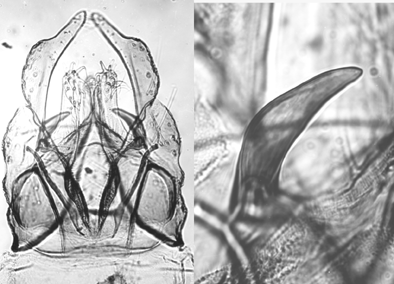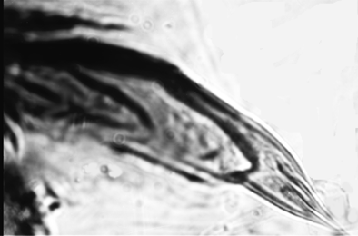Description of C. bifurcatus specimens from egg mass of the type larvaAdult: No information other than the hypopygium.

Male terminalia from egg mass of the Holotype.Pupa: Caudolateral spur of known pupa with only 3 spines.
 Larva: Length 10.2-13.8 mm, lateral tubules sometimes absent, but up to 186 µm in length in others. Posterior ventral tubules longer in half the available larvae, but equal or anterior tubules longer in others. Anal tubules up to 3 times (2.5-2.8) longer than wide.
Gula darkened on posterior half to 2/3, frontoclypeus pale.Mentum of type II (4th laterals reduced almost to level of 5th laterals), central tooth of variable type (IA,B, IIA or III), with c2 teeth relatively separated.
About 30-43 striae on ventromental plates, which are separated by a third or more (0.32-0.43) of the mentum width and 3.38-3.69 times wider than deep.
Pecten epipharyngis with 11-14 teeth sharp teeth (type B). Premandible with inner tooth about 3-4 times wider than the outer tooth.
Antenna relatively short; AR about 2.09 (1.7-2.8); A1 about 2.6-4.1 times longer than wide, Ring organ almost half way up from base (O.32-0.45); segment proportions (microns) 111 : 25 : 7 : 12 : 6.Third inner tooth of mandible hardly separated and with little color (type IA), about 18-22 furrows and 10-13 taeniae in the Pecten mandibularis; MTR 0.27-0.39. This egg mass has the sequences bifA1 and A2, bifB1, bifC1, bifD1, bifE1, bifF1, bifG1 with no median BR. [ Return to Index | Return to C. bifurcatus ] |

